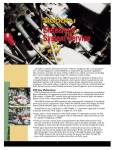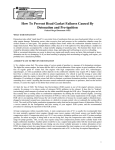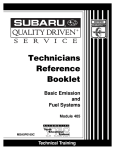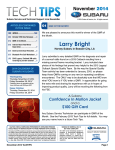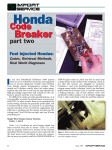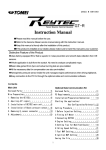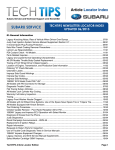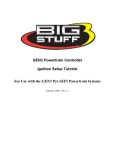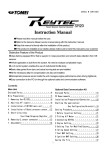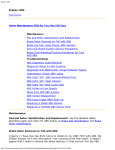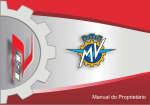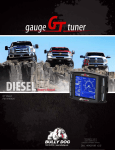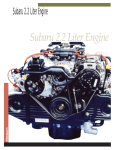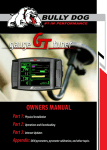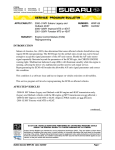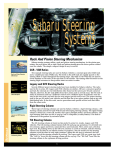Download Fuel Injection and Engine Management
Transcript
Technicians Reference Booklet Fuel Injection and Engine Management Module 406 MSA5P0161C © Copyright 2001 Subaru of America, Inc. All rights reserved. This book may not be reproduced in whole or in part without the express permission of Subaru of America, Inc. Subaru of America, Inc. reserves the right at any time to make changes or modifications to systems, procedures, descriptions, and illustrations contained in this book without necessarily updating this document. Information contained herein is considered current as of October 2001. © Subaru of America, Inc. 2001 Fuel Injection and Engine Management Table of Contents Slide Sequence ......................................................................................................................................................... 5 Introduction ............................................................................................................................................................. 10 Air Induction System .............................................................................................................................................. 10 Fuel Supply ............................................................................................................................................................. 13 Sensors ................................................................................................................................................................... 15 Fuel Injection Logic ................................................................................................................................................ 16 Learning Control ..................................................................................................................................................... 17 Ignition System Control ......................................................................................................................................... 17 Power Supply .......................................................................................................................................................... 19 Self Diagnosis System ............................................................................................................................................ 19 Impreza 1.8 Liter ..................................................................................................................................................... 20 SVX .......................................................................................................................................................................... 22 Inertia Resonance Induction System (IRIS) ........................................................................................................... 23 SVX Ignition ............................................................................................................................................................ 24 SVX Fuel Delivery System ...................................................................................................................................... 25 Fuel Tank Components ........................................................................................................................................... 26 Fuel Tank Servicing ................................................................................................................................................ 26 Sub Assemblies ................................................................................................................................................ 27 Radiator Fan Control ............................................................................................................................................... 27 Relay Control Circuit ........................................................................................................................................ 28 Motor Control Circuit ........................................................................................................................................ 28 Torque Reduction System ................................................................................................................................ 28 1999 Enhancements ................................................................................................................................................ 28 D MPI ....................................................................................................................................................................... 28 Crankshaft and Camshaft Reluctors ................................................................................................................ 30 L MPI ....................................................................................................................................................................... 31 2000 Enhancements ................................................................................................................................................ 32 2001 Legacy Enhancements ................................................................................................................................... 37 2002 Impreza Enhancements ................................................................................................................................. 42 Turbocharger ........................................................................................................................................................... 44 Turbocharger Testing ............................................................................................................................................. 46 Wastegate Control ............................................................................................................................................ 46 Intercooler ............................................................................................................................................................... 47 External Influences On Boost Pressure .......................................................................................................... 49 Ambient Air Temperature and Pressure ............................................................................................ 49 Exhaust Diameter ............................................................................................................................ 49 Fuel Octane Rating .......................................................................................................................... 49 Turbo Lag ........................................................................................................................................ 49 Service Bulletins ..................................................................................................................................................... 52 406 Module Service Help-Line Updates ................................................................................................................. 53 4 October 2001 5 October 2001 Slide Sequence Slide No. 1 2 3 4 5 6 7 8 9 10 11 12 13 14 15 16 17 18 19 20 21 22 23 24 25 26 27 28 29 30 31-37 38 39 40 41 42 43 44 45 46 47 48 49 50 51 52 53 54 55 56 57 58 59 60 61 Description Page No. Title Slide (Boxer Engine Series Module) Created By Teaching Aids Title Slide (Introduction) Current Models Title Slide (Air Induction System) Air Flow Meter Fail-safe Schematic Mass Air Flow Sensor Circuit Idle Air Control Valves Throttle Body with Accel Cable & TPS Potentiometer Operation Throttle Position Sensor Circuit Idle Air Control Valve Turbo Idle Air Control Valve IAC Schematic Fuel Supply Fuel Supply System Fuel Pump Fuel Pressure Regulator Fuel Injector Tip Design Fuel Injector Circuit Sensors Crank Angle Sensor Crank Angle Sensor Reluctor Construction Cylinder Discrimination Signal Cam Angle Sensor and Reluctor Cam Angle Sensor Air Gap Fuel Injection Logic Injection Duration Learning Control Basic Duration Ignition System Control Ignition Circuit Ignition Coil Construction Ignition Coils Ignitor Timing Advance Logic Power supply Ignition Relay Coil Power Ignition Relay Power Distribution Self Diagnosis System Select Monitor and Service Connector Impreza 1.8 Liter Throttle Position Sensor Control Soft Operation Idle Air Control Valve Throttle Body with Wax Pellet A/C IAC 1.8 Impreza Fuel Supply System SVX Throttle Body and Manifold Auxiliary Air Valve Inertia Resonance Induction system (IRIS) 6 10 10 10 10 11 11 11 11 12 12 12 13 13 13 18 14 14 14 15 15 15 15 15 16 16 16 16 16 17 17 17 17 17 18 18 18 19 19 19 19 19 20 20 20 20 21 21 57 22 22 22 23 October 2001 Slide Sequence Slide No. 62 63 64 65 66 67 68 69 70 71 72 73 74 75 76 77 78 79 80 81 82 83 84 85 86 87 88 89 90 91 92 93 94 95 96 97 98 99 100 101 102 103 104 105 106 107 108 109 110 111 112 113 114 115 116 Description Page No. Intake Manifold (Underside) IRIS Valve (Closed) IRIS Valve (Open) with Resonance Tube Resonance Tube SVX Ignition Ignition coil and Spark Plug Knock Sensor Locations Oxygen Sensors Crank and Cam Angle Sensors Throttle Sensor SVX Fuel Delivery System Fuel Delivery System Fuel Tank components Sending Units Assemble and Pump Fuel Tank Servicing Removing Spanner Ring Sub Assembly Retaining Clamp Removing Fuel Pump Removing Sending Unit Radiator Fan Control Fan Control Schematic Torque Reduction System 1999 Enhancements D MPI Fuel Supply Rail Air Assist Injector Idle Speed Control Valve Air Assist Supply Rail Injector AA Camber Tip AA Camber (Air Inlets) Idle Speed Control Valve D MPI (Artwork) L MPI (Artwork) Ignitor coil ECM to Coil Signal Ignition Coil construction L MPI Idle Air Control Solenoid Valve Enhancements Vent Control Piping Fuel Pump (Under Seat) Fuel Drain Fuel Pump (Top View) Fuel Pump (Float Arm View) Fuel Pump (Static Strap View) Static Strap Close-up Fuel Level Sensor Engine Compartment Air Assist Solenoid Valve Intake Air Temperature And Pressure Sensor (Bottom View) Intake Air Temperature And Pressure Sensor (Top View) Air Induction Housing TPS AFR Sensor AFR Sensor Harness 7 23 23 23 23 24 24 24 24 24 25 25 25 26 26 26 26 26 27 27 27 27 28 28 28 28 29 29 29 29 30 30 30 30 31 31 31 31 31 32 32 33 33 33 33 33 34 34 34 35 35 35 35 36 36 36 October 2001 Slide Sequence Slide No. 117 118 119 120 121 122 123 124 125 126 127 128 129 130 131 132 133 134 135 136 137 138 139 140 141 142 143 144 145 146 147 148 149 150 151 152 153 154 155 156 157 158 159 160 161 162 163 164 165 166 167 168 169 170 Description Page No. 2001 Legacy Enhancements Variable Intake Control Valve Closed Variable Intake Control Valve Open Variable Intake Control Valve Chart Variable Intake Control Valve Variable Intake Control Valve Location Component Location Intake Manifold Ignition Coil Complete Ignition Coil and Spring Contact (Apart) Crankshaft Reluctor Crank Angle Graph Cam Angle Signal Pattern EGR Pipe EGR Valve EGR Harness Muffler Muffler By-pass Valve By-pass valve Operation (High Engine Speed) By-pass valve Operation (Low Engine Speed) 2002 Impreza Enhancements Tumble Generator Valve Rail Tumble Generator Valve Motor Vent Hose Tumble Generator Valve Position Sensor Bottom View of Intake TGV Channel Tumble Generator Valve Operation Injector Turbocharger Turbocharger Turbocharger Housing Coolant Connection and Oil Return Oil Supply and Connection Wastegate Wastegate Operation Wastegate Actuator Wastegate Valve Wastegate Duty Solenoid Turbocharger Testing Pressure Gauge Connection Radial Movement Check Axial Movement Check Intercooler Effects of Intercooling Intercooler (Bottom View) Inlet to Throttle Body Intercooler Location By-pass Valve connection Air By-pass Valve Operation By-pass Valve Fuel Pump Controller Terminal Layout Copyright The End 8 37 37 37 37 38 38 38 38 38 39 39 39 40 40 40 40 40 41 41 41 42 42 42 42 42 43 43 43 43 44 44 44 44 44 45 45 45 45 46 46 46 47 47 47 47 47 48 48 48 48 50 50 October 2001 9 October 2001 Fuel Injection and Engine Management Introduction This Technicians Reference Booklet contains information about Subaru Fuel Injection and Engine Management systems. It is not intended to be a stand alone publication on the operation, diagnosis, or repair of any system or component. The objective of this class is to provide training that will assist you with properly diagnosing and repairing the Subaru vehicle in a timely manner the first time. Coverage of information will begin with Subaru Legacy. 7 Air Flow Meter 5 Current Models Only the differences of other models will be reviewed and supplemental information will be provided for you to take back to the dealership. Air Induction System The Air Induction provides the correct amounts of air to the cylinders under a variety of operating conditions and performance demands. Components include: Air Induction Piping Mass Air Flow Meter Throttle Body Idle Air Control Valve Monitoring the amount of air inducted is the main function of the Mass Air Flow Meter. Described as a "Hot Wire" type air flow meter containing no moving parts, the Subaru Mass Air Flow Meter obtains information by monitoring the voltage of a single wire which is exposed to the incoming air flow. There are actually two wires exposed to the air flow. The "Hot Wire" which is positioned downstream of the cold wire to prevent any influence to the cold wire. Engine Control Module logic monitors the temperature of both wires by knowing their resistance values and voltage in the wire. The ECM will attempt to maintain a fixed difference in the temperature of these two wires. The amount of voltage applied to the "Hot Wire" is what finally determines the value of the signal generated or "Air Quotient". Air Quotient (QA), is one of the input signals to the ECM that determines the amount or length of time fuel is injected. Two other inputs are the throttle position signal, generated by the throttle position switch (TPS) and the engine speed (EREV), which is a processed signal by the ECM from input of the crank and cam angle sensors. The Air Induction Piping delivers air from the air filter to the Throttle body , Idle Air Control Valve and the PCV system. Fitting to the components of the Air Induction System must be air tight to prevent unmetered air from entering the intake manifold. 10 October 2001 Fuel Injection and Engine Management 10 8 Idle Air Control Valves Fail-safe Schematic Fail-safe results, the action taken by the ECM in the event a component is not operating within established parameters, will force the ECM to determine injection duration using TPS and EREV only. The installation of improper replacement parts will result in a driveability or no start condition. Verify with your parts department using Vehicle Identification and Production Date numbers as necessary. For example earlier production Legacy Vehicles were equipped with either a JECS or HITACHI produced air flow meter dependent on whether they were Automatic or Standard shift transmission vehicles. 9 Mass Air Flow Sensor Circuit Testing is performed by observing resistance and voltage values. QA Value can be monitored using the select monitor. QA value should increase with engine speed and decrease to approximately 1 volt as engine speed approaches idle. Fail-safe value will result in a constant signal which is not effected by engine speed. 11 Throttle Body with Accel Cable & TPS The Throttle Body regulates the amount of air into the intake manifold, controlling off idle engine speed. Operation of the throttle body is accomplished from the movement of the accelerator cable. Coolant flows through the base of the throttle body to prevent ice from forming. The throttle body is factory set and no adjustment should be attempted to the throttle plate. Adjustment of the throttle cable is suggested at PDI and Periodic Vehicle Maintenance. 11 October 2001 Fuel Injection and Engine Management 13 Throttle Position Sensor Circuit 12 Potentiometer Operation The Throttle Position Switch is mounted to the throttle body and engages to the throttle shaft. Any movement of the throttle shaft results in the movement of a contact inside the ECM that is acting with a potentiometer. At idle the resistance value is high so the voltage signal at the moveable contact is low. As the throttle is depressed the resistance value decreases and the voltage at the moveable contact increases. The voltage signal which ranges from .3 to 5 volts, is used by the ECM to determine the position of the throttle in degrees of opening. The Legacy also used a TPS where the voltage ranged from approximately 5 volts at idle and decreased as the throttle was depressed. An idle switch is also provided which signals idle and off idle to the ECM. Adjustment is possible through the use of elongated mounting holes. Fail-safe operation results in a fixed TPS voltage signal while the ECM uses the idle switch, QA and EREV to control injection duration. Testing is performed by observing voltage and resistance values. The Select Monitor on earlier models will display THV or throttle voltage and illuminate an LED when the idle switch signal is present. Newer models in addition will indicate throttle opening in degrees. 14 Idle Air Control Valve Idle Air Control Valve (IAC) operation controls all idle speeds. Construction includes an air cut valve, duty control valve, intake air passage and a coolant passage. These component parts create a dual control over the IAC. The air cut valve is influenced by the temperature of coolant flowing through the IAC. A bimetallic spring is utilized to act on the aircut valve, opening the valve when coolant temperature is low increasing air flow and idle speed. When coolant temperature is high the bimetallic spring closes the air cut valve and decreases airflow and idle speed. Duty control valve operation is achieved by utilizing two electrical coils, one to open the valve and the other to close it. The ECM controls the ground circuits of the two coils and controls them with a duty signal, pulsing the ground circuits. 12 October 2001 Fuel Injection and Engine Management Failure of the duty control valve or loss of duty signal will leave the duty control valve fully open. With a cold engine the air cut valve is also fully open. This quantity of air flowing through the intake air passage would result in an improper high idle speed. To control this condition the ECM will turn off injectors to reduce idle speed. One injector for a warm engine and two injectors for a cold engine. 15 Turbo Idle Air Control Valve IAC duty ratio can be monitored with the select monitor. Higher duty ratio will keep the valve open longer increasing idle speed. Lower duty ratio provides lower idle speeds. Optimum idle speed for all engine conditions is part of the ECM logic and will increase or decrease IAC duty ratio as necessary to maintain the correct idle speed. The intake air passage can be contaminated with carbon which reduces the air flow. This condition would result in a higher than normal IAC duty ratio. If this condition is suspected clean the IAC valve following procedures outline in the service manual. Fuel Supply 16 IAC Schematic Fail-safe results of the IAC can be miss leading. Failure of the bimetallic spring with the aircut valve in the more open position will result in no problem with a cold engine but as the engine warms the duty ratio of the IAC will be lower than normal to close the duty control valve more to maintain proper idle speed. Failure of the bimetallic spring in the more closed position will result in higher IAC duty ratio with a cold engine but will be normal with a warm engine. 18 Fuel Supply System The Fuel Supply system supplies, regulates and monitors gasoline to the injectors. Components include: Fuel Tank Pump Rollover valve Separator Regulator Injectors 13 October 2001 Fuel Injection and Engine Management The Fuel Tank houses the fuel pump and on AWD models a jet pump. Interference with the rear differential is avoided by shaping the tank in a saddle type design. This design makes it necessary to supply a means of removing fuel from one side of the tank to the other. The fuel pump is on the right side of the tank as viewed from the rear with the jet pump pickup on the left. The speed of the fuel returning to the tank is used by the jet pump to create a siphoning effect transferring fuel from the left side of the tank to the right. The main fuel pump can then pickup the fuel. 19 Fuel Pump The fuel sending units, one on each side of the tank are wired in series to provide the fuel gauge with correct information to show correct fuel level. The fuel pump creates pressure by moving the fuel through a series of impeller vanes and centrifugal force. Pressurized fuel flows through the clearance between the armature and the magnet of the motor to the discharge port of the pump. If the pressure output is too high a relief valve opens and the pressurized fuel exits the pump to the tank. When the pressure returns to normal the relief valve will close. 20 Fuel Pressure Regulator Fuel pressure regulator operation controls fuel pressure by adjusting the size of a passage, through spring tension and manifold pressure, that allows fuel to return to the tank. When manifold pressure is high during acceleration the opening is small allowing less fuel to return to the tank. This provides higher fuel pressure at the injectors. During conditions of low manifold pressure the opening is large allowing more fuel to return to the tank, reducing the fuel pressure at the injectors. A check valve in the regulator maintains pressure in the fuel system after the engine is turned off. CAUTION: THE FUEL SYSTEM IS ALWAYS UNDER PRESSURE. DISCONNECT THE FUEL PUMP AND START THE ENGINE TO REMOVE THE PRESSURE. ALLOW THE ENGINE TO RUN UNTIL IT STALLS AND ATTEMPT TO RESTART. TURN THE KEY OFF. THE SYSTEM IS NOW SAFE TO OPEN. FOLLOW ALL SAFETY PROCEDURES OUTLINED IN THE APPROPRIATE SUBARU SERVICE MANUAL. 21 Fuel Injector 14 October 2001 Fuel Injection and Engine Management The fuel injector is described as a galley or side feed type, that delivers fuel to the intake manifold. Sensors Control is achieved by varying the ground signal of the injector. This is accomplished by the ECM. A magnetic field develops inside the injector when the ground is established. The magnetic field lifts a plunger off of its seat and fuel under pressure enters the injector and exits through the tip of the injector. The design of the tip creates the proper spray pattern that results in the best mixing with air in the manifold. Crank angle sensor operation determines crankshaft position and speed by sensing pulses created by a reluctor passing through a magnetic field. The reluctor is machined to the back side of the crankshaft timing belt sprocket. The shape of the reluctor teeth is very important to the strength and clarity of the signal produced. A chip or deformation on any tooth can result in a driveability or no start condition. The signal generated is A/C and varies from approximately .5 to 1.5 volts. 22 25 Tip Design The time or length of grounding of the injector circuit is referred to as injection duration. The select monitor will display injection duration as "TIM". (Injection Duration) Crank Angle Sensor The crank angle sensor is made from a permanent magnet and a coil of wire. Do not drop the crank angle sensor as the magnet may be damaged or the shape of the sensor which can alter the signal generated. 23 Fuel Injector Circuit 26 Crank Angle Sensor Reluctor Construction The crank angle reluctor has 6 teeth making two sets, each having teeth set at 10, 65 and 97 degrees BTDC. October 2001 15 Fuel Injection and Engine Management The ECM uses the crank angle sensor input to influence or control the fuel and ignition systems.( Determines engine rpm, fuel injection timing, dwell and timing advance.) Fuel Injection Logic 27 Cylinder Discrimination Signal 31-37 Injection Duration The amount of fuel injected or duration is determined by the following: BASIC DURATION + CORRECTION FACTORS + VOLTAGE CORRECTION Basic duration is determined by comparing QA and engine speed. 28 Cam Angle Sensor and Reluctor The cam angle sensor in operation functions the same as the crank angle sensor. The value of the A/C signal is slightly lower and the signal pattern is different. Cam angle sensor reluctor teeth are located on the back side of the left side camshaft sprocket. The ECM uses the cam angle sensor to determine fuel injection sequence and to reference the #1 cylinder. Correction factors include: Start increment Coolant temperature After start Full increment Acceleration Air, fuel coefficient Voltage correction compensates for the injectors time lag affected by battery voltage. 29 Cam Angle Sensor Air Gap 16 October 2001 Fuel Injection and Engine Management Learning Control 42 Ignition Coil Construction Cylinders #1 & #2 - Forward coil #3 & #4 - Rear coil 39 Basic Duration The amount of air monitored by the mass air flow meter or QA compared to the engine rpm is memorized by the ECM. This results in a representation of engine load. Engine load is used to update Basic duration. Ignition System Control The secondary voltage is sent to the spark plugs of two cylinders simultaneously, one cylinder will be on the power stroke and the other on exhaust stroke. CAUTION: DURING CYLINDER "POWER BALANCE" TESTS DO NOT ALLOW FUEL TO ENTER THE EXHAUST SYSTEM. ALWAYS DISCONNECT THE APPROPRIATE FUEL INJECTOR HARNESS, DO NOT SHORT SECONDARY VOLTAGE TO THE CYLINDER. SHORTING THE SECONDARY VOLTAGE WILL ALLOW FUEL TO ENTER THE CYLINDER. THE SPARK PLUG MAY FIRE ON THE EXHAUST STROKE WHEN IGNITION IS RESTORED. THIS MAY CAUSE SEVERE DAMAGE TO THE EXHAUST SYSTEM. NEVER START THE ENGINE WITH THE EXHAUST REMOVED AS THE CYLINDER FIRING ON EXHAUST STROKE MAY IGNITE UNBURNED FUEL. 41 Ignition Circuit The distributorless (direct ignition) system uses the crank and cam angle sensor inputs processed by the ECM to control ignition and ignition timing. This system uses a coil pack that houses two coils that separately supply secondary voltage to two cylinders. 17 October 2001 Fuel Injection and Engine Management 43 45 Ignition Coils Timing Advance Logic The coils are controlled by the ignitor. Ignitor construction is composed of two transistors that control the ground circuits of the primary windings of the coils. Transistors in the ECM control the ignitor. The ignitor is necessary because of the amperage flow through the primary windings would damage the ECM. Optimum ignition timing is stored in the ECM. Timing is controlled to be just below the time of engine knock. Engine knock is detected by the Knock Sensor. The sensor contains a piezo electric element that generates a small A/C voltage signal when a vibration at the correct frequency is present on the engine block surface. The signal that is created is used by the ECM to influence ignition timing. 44 Ignitor Signals from the cam and crank angle sensors are received by the ECM. At engine start the ignition timing is fixed at 10 degrees BTDC. After engine start ignition timing is influenced by the mass air flow meter, coolant temperature, knock sensor and engine load. 18 October 2001 Fuel Injection and Engine Management Power Supply Self Diagnosis System Self diagnosis has four modes: U-check - monitors components necessary for start up. The check engine light will be illuminated during normal vehicle operation when a problem is detected. Read Memory - Used at the dealer to read past trouble codes. Activated by using the black connectors located under the driver side kick panel, and following the procedures outlined in the service manual. 47 Ignition Relay Coil Power D-check - Used at the dealer to check the present condition of all MPFI components. Activated by using the green connectors located under the driver side kick panel, and following the procedures outlined in the service manual. Clear memory - Clears all codes in ECM memory. Activated by using the green and black connectors located under the driver side kick panel, and following the procedures outlined in the service manual. 48 Ignition Relay Power Distribution 50 Select Monitor and Service Connector In both D-check and Read Memory modes, the control unit outputs trouble codes by using the Check Engine Light. Long flashes equal 10 and short flashes equal 1. By adding together the numerical equivalent of the flashes, you can identify the correct trouble codes. Multiple trouble codes are outputted in chronological order. You will find a list of trouble codes in the service manual. Always refer to the appropriate MY service manual when identifying trouble codes. 19 October 2001 Fuel Injection and Engine Management If the self-diagnostic system does not output trouble codes indicating a fault in the MPI system, suspect components may be checked using the check procedures found in the appropriate MY service manual. Self Diagnosis for other Subaru models are similar, however, test connector shapes may be different. Consult the appropriate service manual for connector location and diagnosis procedures. Impreza 1.8 Liter 53 The Impreza 1.8 Fuel and Engine Management system differs from the Legacy in the following : TPS IAC Throttle Body Fuel Tank Power Supply Control Soft Operation 54 Idle Air Control Valve 52 Throttle Position Sensor The Throttle Position Sensor is connected to the throttle body similar to Legacy. The major difference is the way the idle signal is generated. Impreza uses a "soft idle control", a .5 volt signal that comes from the moveable contact and the potentiometer. Throttle position signal and idle can be observed with the Select Monitor. Throttle body size and shape differs from Legacy and serves as a mounting for the IAC valve. The IAC valve uses a Duty Control Valve operated from an ECM duty ratio. Control of idle speed during all engine operating conditions is performed by the Duty Control Valve. 20 October 2001 Fuel Injection and Engine Management The fuel tank design and capacity does not make it necessary to use a jet pump to transfer fuel on the 1.8 liter engine vehicle. 55 Throttle Body with Wax Pellet However, during cold engine operation it is assisted by a coolant sensitive device that contains a wax pellet. The wax pellet contracts when it is cold and expands when it is heated. During cold operation a spring loaded lever resting on the end of the pellet moves toward the pellet. The opposite end of the lever is cam shaped. 57 1.8 Impreza Fuel Supply System 56 A/C IAC As it moves upward it pushes on the throttle shaft, mechanically increasing the idle speed. Increasing coolant temperature expands the pellet relaxing the force applied to the throttle shaft. There is also an A/C IAC that allows additional air flow by pass the throttle plate to compensate for load the air conditioner places on the engine. CAUTION: THE A/C IAC IS FACTORY SET, DO NOT ADJUST. THIS VALVE WILL BE ACTIVATED WHEN THE AIR COMPRESSOR IS ENGAGED FROM AN ECM SIGNAL. 21 October 2001 Fuel Injection and Engine Management SVX Differences of the SVX fuel injection and engine management system include: Air Induction Ignition Sensors Fuel Supply Power Supply The Air Induction system components of the SVX include an Idle Air Control Valve, Auxiliary Air Control Valve and piping. An Inertia Resonance Induction system is also employed to improve low to mid range torque. 60 Auxiliary Air Valve Cold engine operation results in the bimetallic spring forcing the rotary valve open to increase airflow by-passing the throttle plate. The heater becomes active after the engine is started heating the bimetallic spring. As the spring changes tension the rotary valve is gradually moved to the closed position reducing idle speed. 59 Throttle Body and Manifold IAC valve operation is accomplished with a duty signal from the ECM which acts on the Duty control valve. The IAC controls base idle, compensates for additional engine load conditions, such as A/C operation, and assists the Auxiliary Air Valve with cold idle control. Auxiliary valve construction includes a rotary valve, bimetallic spring and heater. 22 October 2001 Fuel Injection and Engine Management Inertia Resonance Induction System (IRIS) IRIS operation includes two modes. Mode one is active from low to approximately 4200 RPM. The IRIS valve is closed separating the two sides of the intake manifold. Construction of the intake manifold includes a resonance tube that in mode one synchronizes the intake pulses. Simply stated the air filling one cylinder will continue to move after the intake valve has closed. That air will push the air in front of it into the next cylinder in the firing order. In mode one the resonance tube guides the moving air to the opposite side of the manifold as the firing order is 1-6-5-4-3-2. 62 Intake Manifold (Underside) Iris system components include: IRIS Valve Vacuum Tank Check Valve Solenoid The solenoid provides a vacuum pathway from the IRIS valve to the vacuum storage tank to close the valve and to the atmosphere to open it. Vacuum storage is accomplished with the storage tank and is maintained there with the use of a check valve, for conditions of low manifold vacuum. 64 IRIS Valve (Open) with Resonance Tube The IRIS valve is closed because the volume of air in mode one is moving too slow for the valve to be effective. Resonance tube operation maintains the speed of the moving air, keeping the pushing effect at maximum. 63 65 IRIS Valve (Closed) Resonance Tube Air flow volume in mode two is too great for the small size of the resonance tube, so just above 4200 rpm the IRIS valve opens and guides the air as in mode one. October 2001 23 Fuel Injection and Engine Management SVX Ignition 69 67 Ignition Coil and Spark Plug The ignition system of the SVX uses a coil for each of the six cylinders. Coil mounting is accomplished by a captured bolt that goes through the valve cover into the cylinder head. Primary and secondary windings are contained in the coil with a spring loaded contact that completes the secondary circuit to the spark plugs. Oxygen Sensors Oxygen sensors are located in the left and right side exhaust pipes ahead of the catalytic converters. Separate alpha readings are available for display on the select monitor. The primary circuit is controlled by an ignitor that pulses the ground circuit from a signal generated in the ECM. 70 Crank and Cam Angle Sensors Two crank angle sensors are installed above the crankshaft sprocket. Crank sensor #1 determines crankshaft position and Crank sensor #2 determines the next cylinder in the firing order. Cam angle sensor input is used with the crank angle sensor to discriminate between cylinders. 68 Knock Sensor Locations The Knock sensors are located on each side of the engine. If either sensor detects a knock the overall ignition timing is reduced. 24 October 2001 Fuel Injection and Engine Management SVX Fuel Delivery System The fuel pump system located inside the fuel tank is similar to the Legacy. It receives its basic power supply from the fuel pump relay. 71 Throttle Sensor Throttle sensor operation is more similar to Impreza than Legacy. An idle switch is not used rather a reference voltage of approximately .5 volts is used. The voltage will increase as the throttle moves toward wide open with a maximum of 5 volts. A return spring inside the TPS provides a smooth drop voltage as the throttle is released to idle. 73 Fuel Delivery System An electronic volume control system has been added which reduces fuel evaporation by creating less fuel agitation through the fuel system during low fuel demand driving conditions. The electronic fuel pump “modulator Unit” is located under the right side of the package shelf. It completes the ground circuits for the fuel pump. There is a direct ground and a resistance ground. A fuel pump resistor is located next to the fuel pump modulator. It is wired to the pump in parallel with the modulator. The ECM monitors injector pulse width and engine speed in order to reduce fuel flow during low load and low RPM conditions. The ECM signals the modulator to send the fuel pump ground through the resistor, providing minimum fuel flow during low load conditions. Under high load/high RPM conditions, the ECM signals the “modulator unit” to supply a direct ground to the fuel pump, providing a high fuel flow condition. 25 October 2001 Fuel Injection and Engine Management Fuel Tank Components Fuel Tank Servicing The fuel tank is a saddle tank design made of resin. This provides a weight savings as well as corrosion resistance. It is located under the rear seat area. The tank design allows for air space which eliminates the need for a fuel separator. It forms a 10 liter air chamber at the top of the tank. The fuel shut off valve is part of the tank cover assembly. The valve incorporates a float which prevents liquid fuel intrusion into the vapor hose to the charcoal canister. Example: Fuel slosh during hard driving Fuel tank components are serviceable with the tank in vehicle. They are accessed through a large opening in the top of the tank similar to the Legacy. 77 Removing Spanner Ring Remove all of the fuel tank components in order. Start with the spanner ring using service tool #42199PA000. Then remove the cover after disconnecting the fuel hoses from the pipes in the tank. NOTE: MARK THE HOSES SO THEY CAN BE CORRECTLY REINSTALLED ON THE DISCHARGE “D” AND THE RETURN “R” LINES. Disconnect the 2 electrical connectors for the fuel pump and the fuel gauge sending unit. Push the wires back into the tank and remove the crossover hose with its retaining clips. 75 Sending Units Assemble and Pump In addition to the fuel pump, there are two sending units mounted inside the fuel tank; a main unit and a sub unit. The main unit incorporates a low fuel sensor. The function and diagnostics for the sending units is similar to the Legacy. 78 Sub Assembly Retaining Clamp Now reach inside the tank and remove the metal retaining clamp by lifting the two tabs on the left side of the clamp. NOTE: THERE ARE THREE ASSEMBLIES INSIDE THE TANK. EACH ASSEMBLY COMES OUT SEPARATELY AND IN ORDER. 26 October 2001 Fuel Injection and Engine Management Sub Assemblies Lift the right hand sending unit assembly from the molded bracket and temporarily set it aside inside the tank. Then lift the fuel pump assembly from the molded bracket. Radiator Fan Control The radiator fan uses five (5) relays which are located in the main fuse box behind the battery. They are 4 pole (NO) type relays. 71 82 79 Fan Control Schematic Removing Fuel Pump Remove the fuel pump assembly by gently rotating it back and forth. Then gently rotate the right hand sending unit clockwise in order to just clear the tank. Next, disconnect the electrical connector from the sending unit and remove the right hand sending unit from the tank. 80 The three speed, dual fan operation allows for quieter operation during idle conditions and it allows for increased air flow during other operating modes. Example: Slow speed driving The two 3 speed 160 Watt Fans each have two (2) B+ control wires and two (2) ground wires. The relays are controlled by the ECM. The ECM provides 2 separate control signals (signals #1 and #2) to the fan relays. Signal #1 determines low speed for the left hand and right hand fans. Signal #2 determines “medium speed”” and signals #1 and #2 combined provide high speed. Several ECM inputs determine the fan operating speeds: Coolant temperature A/C compressor “ON/OFF” condition Removing Sending Unit A/C Pressure switch Gently rotate the left hand sending unit counter clockwise until it is upside down. Remove the assembly with the wiring harness attached. Vehicle speed CAUTION: WHEN REMOVING THE SENDING UNITS, USE CARE SO AS NOT TO BEND THE FLOAT ARMS. THIS CAN AFFECT THE FUEL GAUGE CALIBRATION. For reassembling the fuel tank components, reverse the order of disassembly. 27 October 2001 Fuel Injection and Engine Management Relay Control Circuit Battery B+ power is provided by the ignition switch to all of the relay coils. ECM signal #1 supplies grounds to relay coils #1 and #4 (low speed). Signal #2 grounds relay coils #3, #2 and #5. Motor Control Circuit Relays #1 and #4 supply B+ power to one positive terminal of each fan motor. Relay #1 powers the left hand motor and relay #4 powers the right hand motor. Relays #2 and #5 (mid speed) supply B+ power to the other positive terminal of each fan motor. Relay #5 supplies the right hand motor and relay #2 supplies the left hand motor. Relay #3 supplies an additional ground to both the left hand and right hand motors. Two (2) fused (20A) circuits supply B+ power for each motor relay power supply circuit. A fuse protection function is part of the ECM fan control section. It initially limits the fan to start from low speed. Then it goes through medium to high speed during hot start-up conditions. 1999 Enhancements The fuel injection and engine management control system for the 1999 model year will be designated L MPI and D MPI. EXCEPT LEGACY 2.5 PHASE 1, WHICH WILL USE THE SAME FUEL AND ENGINE MANAGEMENT SYSTEMS THAT WERE EQUIPPED ON THE 1998 MODEL YEAR VEHICLES. These sequential systems are similar in design sharing most operating and diagnostic functions. The most noticeable difference is the D MPI system, which is California Specification, uses new style air assist injectors. D MPI The air assist fuel injector is supplied with fuel from a supply rail, which is connected to the top of the injector. By gradually increasing the fan speed from Low to Medium and then to High, a large current surge across the fuses is prevented. Torque Reduction System 86 Fuel Supply Rail 83 Referred to as top feed, this style injector internally functions the same as injectors used on previous model years. Torque Reduction System The 3.3L ECM differs from the 2.2L ECM in the following ways. It has a torque reduction system networked between the TCM and the ECM which reduces shift shock during upshifts when the engine is under a high RPM load (above 6000 RPM or at WOT). ECM momentarily activates fuel cut at the time of the shift. Also has a "soft" control program for enhanced idle speed control. Provides smoother, more precise idle speed control. 28 October 2001 Fuel Injection and Engine Management 87 89 Air Assist Injector Air Assist Supply Rail Externally the injector is sealed at the top and bottom with O-rings and double lip seals. Additionally the air assist injector is supplied with air from the Idle Speed Control Valve. The negative pressure area below the injector is constantly filled with the more positive pressure air from the ISC. The air must travel through a chamber attached to the bottom of the injector. 88 90 Idle Speed Control Valve Injector AA Chamber Tip This air is used to provide faster atomization of the fuel, providing lower emission output and improved driveability. The air from the ISC is delivered through a passage made into the intake manifold to the bottom of the injector. 29 October 2001 Fuel Injection and Engine Management The Pressure Sensor of the D MPI system is a strain type sensor. A set of resistors is mounted to the diaphragm inside the sensor. Changes in pressure of the intake manifold alter the shape of the diaphragm and to the resistors. The changing resistance value is sent to the engine control unit as an input signal. Crankshaft and Camshaft Reluctors 91 AA Chamber (Air Inlets) The chamber has 4 small holes that meter the air into the fuel stream, beginning the atomization process when the injector is turned on. Looking through the two lower holes of the chamber the four holes of the injector are visible. 93 D MPI 94 L MPI 92 Idle Speed Control Valve The Idle Speed Control Valve of the D MPI system is a rotary type controlling all idle speeds. The electrical operation of the ISC itself includes a closing coil and an opening coil. The close coil is always on, trying to close the rotary valve. The opening coil is controlled by a signal or duty ratio from the Engine Control Unit, adjusting the ISC to maintain the correct engine idle speed. Part of the controlled air by-passes the throttle plate effecting idle speed. The remainder is delivered to the injectors. The crankshaft and camshaft reluctor of the D MPI system are used to influence ignition and injection timing. The number of teeth on the two reluctors differs from those of the L MPI. Installation of incorrect components will result in a no start condition. The additional teeth assist the Engine Control Unit to shorten the time for cylinder discrimination and improve accuracy of misfire detection. Off idle engine operation results in a larger amount of air delivered to the injectors. 30 October 2001 Fuel Injection and Engine Management L MPI 95 Ignitor Coil The ignition coil and ignitor are now one unit. A 12-volt square wave signal is sent to the coil from the ECM to control the ignitor. The ignitor in turn controls the coil primary winding. 99 Idle Air Contol Solenoid Valve The injectors of the L MPI system are sealed to the fuel rail and intake manifold in the same manner as the D MPI. Missing is the atomization chamber located below the injector. Operation and diagnostic procedures are also shared. The ISC of the L MPI system is a stepping type solenoid valve, which consists of coils, shaft, permanent magnet, spring and housing. The housing is built into the throttle body. 96 ECM to Coil Signal In operation current flows sequential through a series of paired coils which are arranged to react with the permanent magnet that is fixed to the shaft. The ECM controls the polarity of the coils, which effects the position of the permanent magnet. This action rotates the threaded shaft of the ISC increasing or decreasing the depth of the air-sealing surface. When replacing or installing the ISC it must be initialization accomplished by turning on the ignition with the engine off for at least three seconds. The engine may now be started. 97 Ignition Coil Construction 31 October 2001 Fuel Injection and Engine Management The pressure sensor and pressure sources switching solenoid are of the style used in 1998 Subaru vehicles, sampling atmospheric pressure at start up and then cycling over to measure manifold pressure. The coil and knock sensor of the L MPI are also sheared with the D MPI. 2000 Enhancements The fuel tank and ORVR components have been relocated on the vehicle. This makes necessary movement of key fuel system plumbing. On such movement involves this new hose. The throttle position sensor functions the same as the D MPI except it is adjustable. The L MPI system utilizes and Air flow meter with the same operating characteristics of the Air Flow Meter used on the 1998 Model Subaru vehicles. Oxygen sensors of the L MPI are the same as used on the 1998 model year vehicles. 101 Vent Control Piping This hose is routed from the fuel neck to the vent control valve located on the driver’s rear of the fuel tank. The routing carries the hose through the inner fender into the passenger compartment. The hose is protected by a metal cover, which must be removed to gain access to the quick connector. The quick connector must be disconnected before the fuel tank is lowered. Movement of the fuel tank is accompanied by a change in the fuel pump assembly design and location. The fuel pump assembly and sub pump pick up assembly are now accessed from under the rear seat. The pumps are located on the lower level of the fuel tank which makes it necessary to remove the fuel from the tank before removing the fuel pump or sub pump pickup assemblies. Failure to remove fuel from the tank will result in fuel being introduced into the passenger compartment. 32 October 2001 Fuel Injection and Engine Management 102 104 Fuel Pump (Under Seat) Fuel Pump (Top View) A fuel drain is located on the passenger side, front of the fuel tank. Use of this drain will lower the fuel from the high side of the tank and totally drain the passenger side of the saddle tank. The sub pump pickup side, (the drivers side) of the tank, will remain full. Consult the appropriate Subaru service manual on proper procedure for draining all fuel from the fuel tank. 105 Fuel Pump (Float Arm View) This round housing is designed to accept a fuel filter however; the North American market will not use a filter located on the fuel pump. 103 Fuel Drain The body of the new fuel pump assembly is resin based. The gasket for the assembly has two location prongs that must be pulled into the outer cover. 106 Fuel Pump (Static Strap View) The small wire connected to cap area of the fuel pump housing carries static charges away from the pump body to vehicle ground. 33 October 2001 Fuel Injection and Engine Management 107 Static Strap Close-up 109 The low fuel level sensor operation has been enhanced. The sensor itself works the same however, the low level when sensed triggers a circuit located in the fuel gauge to maintain the low level indicator illumination until the tank has had fuel added. Engine Compartment Two fuel systems will be used for the 2000 model year, the AAI UJ and AAI ND systems. The AAI UJ system will be equipped on the Legacy automatic, Impreza 2.5 liter, and all Forester models. The AAI ND system will be equipped on the Legacy manual transmission and Impreza 2.2liter models. The ND system closely resembles the D MPI system that is currently equipped on 1999 California spec models with changes only to the ECM logic. 108 Fuel Level Sensor All Legacy vehicles will be equipped with phase 2 2.5 liter engines using the D MPI fuel systems, (California Spec) making the 2000 model Legacy a 50 state car. The UJ system has two new components, an AAI Air Assist Solenoid Valve and an Intake Air Temperature and pressure sensor. The Air Assist Solenoid Valve is connected to the inlet side of the ISC, which requires the Air Assist Solenoid Valve to regulate the air to the base of the injector. The ND system regulates the air to the base of the injector with the ISC. At idle the Air Assist Solenoid Valve is on allowing 20L/min per injector of air to flow. Off idle conditions result in the Air Assist Solenoid Valve turning off allowing only 5L/min per injector of airflow. 34 October 2001 Fuel Injection and Engine Management 112 110 Intake Air Temperature and Presure Sensor (Top View) Air Assist Solenoid Valve The new Intake Air Temperature and pressure sensor monitors the absolute pressure and the temperature of the air in the intake manifold. The measured temperature and pressure of the air is then converted into electrical signals and sent to the ECM. The ECM uses those signals from the sensor to control the fuel injection amount as well as the injection and ignition timing. The air induction housing provides air to the throttle body and begins to form the turbulence needed in the combustion chamber for proper air fuel mixing. Only the UJ system continues to use the Atmospheric pressure sensor located on the right strut tower. This sensor works with the AFR to monitor air density. 113 Air Induction Housing The throttle position, idle speed control motor, and ignition coil have not been changed. 111 Intake Air Temperature and Presure Sensor (Bottom View) The intake manifold pressure sensor is connected directly to the throttle body, and constantly measures the absolute pressure of the intake manifold. The pressure that is measured is converted into an electrical signal, and is sent to the ECM. The ECM controls the fuel injection and ignition timing based on the intake manifold absolute pressure signal from the pressure sensor. 106 35 October 2001 Fuel Injection and Engine Management 116 114 TPS The throttle position, idle speed control motor, and ignition coil have not been changed. AFR Sensor Harness The sensor harness includes an electrical compensation device that allows for manufacturing tolerances. 115 AFR Sensor A new type air fuel ratio sensor is used on the UJ system. The harness includes a new-style locking mechanism. Position the locking mechanism as shown and gently separate the vehicle harness from the sensor harness. 36 October 2001 Fuel Injection and Engine Management The airflow valve closes during the low to middle engine speeds to control the resonance effect and opens during high engine speeds to increase the inertia effect. 2001 Legacy Enhancements 118 Variable Intake Control Valve Closed Resonance effect is created during the intake stroke when the intake valve begins to open. The combustion chamber contains a large negative pressure created by the exhaust stroke. This negative pressure will enter the intake runner through the open intake valve creating a shock wave as it is traveling at sonic speeds. This will create a resistance to the flow of the new air charge into the combustion chamber. Left uncontrolled this resistance would spread to all parts of the intake manifold and decrease airflow and overall engine performance. Keeping the airflow valve closed during low to middle speed engine operation will keep the resonance effect isolated to one side of the intake. As the engine crosses beyond mid-range the inertia effect becomes strong enough to overpower the resonance effect and the airflow valve is opened. This will allow air moving on the LH side of the manifold to assist the RH side. 119 Variable Intake Control Valve Open The variable Induction control system opens and closes an airflow valve which is located in the middle of the intake manifold. This action joins or separates the LH and RH sides of the intake manifold. 120 Variable Intake Control Valve Chart Components of the system include the airflow valve, vacuum tank, check valve, solenoid and associated piping. 37 October 2001 Fuel Injection and Engine Management 121 123 Variable Intake Control Valve Component Location 122 124 Variable Intake Control Valve Location Intake Manifold The variable intake control valve is positioned on the under side of the intake manifold. The valve is controlled by the variable intake control solenoid which receives its operating signals from the ECM. The vacuum storage for the solenoid is built into the manifold as a separate tank. When a signal from the ECM is generated to the solenoid the vacuum in the reservoir tank (Figure 87) is routed from the solenoid to the variable intake control valve. This action will close the valve and in the event of low manifold vacuum, the check valve will keep the vacuum to the variable intake control valve steady. When the ECM is ready to open the variable intake control valve the solenoid will be turned off and vent the vacuum from the variable intake control valve to the atmosphere. 125 Ignition Coil Complete 38 October 2001 Fuel Injection and Engine Management The new crank angle sensor is mounted to the flywheel end of the crankshaft. This end of the crankshaft has less torsional vibrations and offers a more stable signal generating area, providing very accurate crankshaft signals. As the crankshaft rotates the reluctor produces 30 pulses which are sent to the ECM. The indicated reluctor teeth represent the signals for cylinders. 126 Ignition Coil and Spring Contact (Apart) Direct Ignition coils are used for each cylinder. They contain the ignitor, current control circuit as well as the primary and secondary windings. A 12 square wave sent from the engine control module turns the primary circuit on and off. (Figure 89-90) As the signals from the crank angle sensor are produced they will have a cam signal associated to them ever other revolution. Position A without a cam signal is cylinder 4 and with a cam signal is cylinder 3. Position B without a cam signal is cylinder 2 and with a cam signal is cylinder 1. Position C without a cam signal is cylinder 6 and with a cam signal is cylinder 5. The right bank intake camshaft has a reluctor built onto the end. The new camshaft sensor uses this reluctor to help determine injection and ignition timing. 128 Crank Angle Graph 127 Crankshaft Reluctor Cylinder - Cam Signal 1-Yes 6-No 3-Yes 2-No 5-Yes 4-No The cam sensor consists of two elements or windings that sense the slot on the cam shaft reluctor. The sensor also contains an integrated chip that produces a square wave output signal (5 volts). The integrated chip measures the time lag between the beginning and ending of the signals picked up by the two elements, (Hall effect) and converts this information into the output signal. 39 October 2001 Fuel Injection and Engine Management 132 129 Cam Angle Signal Pattern EGR Harness An electronic Exhaust Gas Recirculation valve is utilized on the EZ-3.0 Engine. The ECM controls the number of steps (stepping motor) the valve is opened. Each step will allow a certain amount of exhaust gas to flow through the valve. The ECM will check the performance of the valve (OBDll) by opening the EGR valve to a specified number of steps. The resulting manifold pressure changes are monitored to determine if the performance of the valve is in specifications. 130 EGR Pipe 133 Muffler 131 EGR Valve 40 October 2001 Fuel Injection and Engine Management 134 136 Muffler By-pass Valve By-pass Valve Operation (Low Engine Speed) The muffler equipped on the EZ-3.0 Engine is designed with a by-pass valve that opens when the exhaust pressure exceeds 45 mm HG. This occurs around 2400 RPM. The by-pass valve allows parts of the exhaust to go around some of baffles inside the muffler instead of through them. The result is increased engine performance. 135 By-pass Valve Operation (High Engine Speed) 41 October 2001 Fuel Injection and Engine Management 2002 Impreza Enhancements 140 Vent Hose 138 Tumble Generator Valve Rail 141 Tumble Generator Valve Position Sensor 139 Tumble Generator Valve Motor The EJ-2.0 is equipped with a tumble generator valve at each intake runner. This new system uses a shaft for each side of the engine that is driven by a stepper motor. The movement of the shaft is monitored by a sensor on the opposite end. The shaft operates the tumble generator valve, which is a plate similar in design to the throttle plate. At idle the plate is closed (dependant on coolant temperature and time from engine start). Off idle the plate is open. 42 October 2001 Fuel Injection and Engine Management 142 Bottom View of Intake 143 144 TGV Channel When the plate is closed the main air passage through the intake runner is blocked. This will force all air necessary for engine operation during idle to flow through the by-pass channel. This action helps to mix the air fuel mixture by producing a tumbling effect to the incoming air, resulting in a cleaner operating engine while idling. Tumble Generator Valve Operation 145 Injector The new fuel injector is a top feed type with 12 holes. The new hole pattern produces a finer spray of fuel which assists with lowering the overall emission output of the vehicle. (No air assist on Turbo models.) 43 October 2001 Fuel Injection and Engine Management Turbocharger The introduction of the 2.0 liter engine to North America reintroduces the Turbocharger which was last used on the 1994 Legacy 2.2 liter. The new Turbocharger and fuel system have been designed to produce higher engine performance and lower exhaust emissions. 147 The Turbocharger consists of two sections, an exhaust side and an induction side. The exhaust side has a turbine wheel with vanes that are shaped to harness the exhaust gas energy. This drives the turbine and center shaft . On the induction side there is an impeller wheel attached to the center shaft which also has vanes but shaped in the opposite direction. The movement of the wheel compresses the induction air as it rotates. Increasing engine speed and load increases the level of kinetic energy in the exhaust gas making the turbine rotate faster. This causes the impeller, which is attached to the common center shaft, to also rotate faster creating greater compression of the induction air. Rotational speeds of the turbine are in the range of 20,000 rev/min. at idle to 150,000 – 200,000 rev/min. at full power. As a result of these very high operating speeds and temperatures, makes lubrication and cooling of the center shaft bearings of prime importance. Turbocharger (Artwork) 149 Coolant Connection and Oil Return 148 Turbocharger Housing 150 Oil Supply and Connection 44 October 2001 Fuel Injection and Engine Management The shaft bearings are lubricated by a constant supply of engine oil. An oil cooler positioned above the oil filter transfers heat from the oil to the engine coolant. Further cooling of the Turbocharger is achieved by coolant fed from the right cylinder head to coolant passages around the exhaust turbine bearing. 153 Wastegate Actuator 151 Wastegate 154 Wastergate Valve 152 Wastegate Operation Due to the limited strength of the engine there is a limit to the amount of boost pressure that can be used. The limiting of boost pressure is achieved by the use of a ‘wastegate’, which bypasses the exhaust gas around the turbine wheel when the desired level of boost is reached. The ECM references a boost pressure map programmed into Read Only Memory (ROM) after first reading the input signals. By calculating the actual boost pressure, and after compensating for engine temperature and atmospheric pressure, the ECM is able to provide an output duty ratio signal to the Wastegate Control Solenoid. This regulates the amount of pressure applied to the wastegate controller diaphragm by leaking off boost pressure to the inlet side of the turbine. 45 October 2001 Fuel Injection and Engine Management Turbocharger Testing Wastegate Control 157 155 Wastegate Duty Solenoid The wastegate controller (in response to the Duty Solenoid) opens the wastegate flap valve to bypass exhaust gas and so decrease the rotating energy of the turbine keeping the boost pressure to the desired level. When operating at increasing altitudes, the atmospheric pressure becomes lower and therefore the difference between the desired level of boost pressure and atmospheric pressure becomes greater. To maintain the same level of boost pressure the air must be compressed more which requires more turbine rotating energy. Therefore less boost pressure is applied to the wastegate controller via the solenoid valve and boost remains constant. Pressure Gauge Connection Attach a regulated pressure supply directly to the wastegate actuator hose connection. The actuator should begin to open at approx. 50.0 - 60.0kPa. (7.2 - 8.7 p.s.i.) Check all associated hoses for damage or loose connection. The Turbocharger should be visually inspected for any damage to the compressor or turbine wheels. Check for any oil that may be present in the turbine housing. A small amount of oil due to crankcase ‘blow by’ is acceptable in the compressor housing. However, at very high altitudes the extra compression of the air at maximum boost causes a too high intake air temperature even after intercooling and engine knock will occur. Therefore it is necessary to decrease the maximum boost pressure at very high altitudes. 46 October 2001 Fuel Injection and Engine Management Intercooler The Turbocharger compresses the intake air by using wasted exhaust gas energy. The Turbocharger turbine is driven by exhaust gas, causing the compressor wheel to rotate. By compressing the intake air, the volumetric efficiency of the engine is greatly improved. The compression of the intake air by the Turbocharger causes an increase in air temperature, so an intercooler is located between the Turbocharger and the intake manifold. The intercooler reduces the temperature of the intake air from 248-266°F (120°-130°C) down to 158176 F (70°-80°C) under normal operating conditions. 158 Radial Movement Check An Air By-Pass Valve redirects high pressures from the intercooler back to the inlet side of the Turbocharger under deceleration. Before testing the electronic components in the boost control system, be sure that the wastegate is operating correctly. Utilizing a dial gauge, measure the radial movement of the turbine shaft by accessing it through the oil outlet hole. Radial play should not exceed 0.17mm. (.006 inches) To measure the axial movement of the turbine shaft, place the dial gauge against the end of the shaft at the turbine end, and push against the compressor end of the shaft. Axial play should not exceed 0.09mm. (.003 inches) 161 Effects of Intercooling 162 159 Intercooler (Bottom View) Axial Movement Check 47 October 2001 Fuel Injection and Engine Management 165 163 Inlet to Throttle Body The temperature of the intake air is increased as it is compressed by the Turbocharger. This rise in temperature causes a corresponding expansion of the air, leading to a reduction in air density. The intercooler is designed to transfer the heat of the compressed intake air to the external air flowing through as the vehicle is in motion. There are two positive by-products of decreased air temperature and increased air density: one; a reduction in combustion chamber temperature allowing for more advanced ignition timing, and two; improved volumetric efficiency due to the increase in air mass for a given air volume. With a denser air charge into the combustion chamber, more fuel can be injected leading to greater power output. By-pass Valve Connection The Air By-pass Valve is located after the Turbocharger, and provides a by-pass passage for the compressed intake air back to the inlet side of the Turbocharger. When deceleration occurs immediately after a period of high engine load (high boost pressure), a large pressure differential occurs at the compressor wheel of the Turbocharger. This is due to the inertia of the Turbocharger, which still generates boost pressure even though the throttle is fully closed. This high pressure may lead to increased noise, and possibly damage the Turbocharger due to the high pressure exerted at the compressor. 166 Air By-pass Valve Operation 164 Intercooler Location 48 October 2001 Fuel Injection and Engine Management 167 By-Pass Valve The upper chamber of the by-pass valve is connected to the intake manifold, and the negative pressure (vacuum) during deceleration opens the valve by acting on the diaphragm. Operation of the valve can be tested by attaching a hand held vacuum pump to the intake manifold connection. Apply a negative pressure with the pump and confirm that the valve opens. External Influences On Boost Pressure Ambient Air Temperature and Pressure As air temperature rises, the ability of the Turbocharger to compress the air decreases. This phenomenon is directly due to the decrease in air density and the physical limitation of the Turbocharger. Even when air temperature is low, the air density (barometric pressure) may be low. Under these conditions, lower than expected boost pressures may be experienced. Again this is due to the physical limitations of the Turbocharger. Exhaust Diameter The diameter of the exhaust system will vary the pressure difference across the turbine. A larger exhaust allows the Turbocharger to rotate faster, which results in higher boost pressures. Any increase in boost pressures would require ‘remapping’ of the ECM programs to accommodate different air flow rates and resultant ignition change requirements. Over speeding of the turbine can lead to Turbocharger failure, particularly in conjunction with the increase in the pressure differential across the turbine. Fuel Octane Rating The high combustion pressures resulting from the increase in volumetric efficiency require a high-octane fuel. If the octane of the fuel is too low, knocking will occur. The end result of knocking is damage to the engine. The ECM is programmed to retard ignition timing if knocking is detected. Excess knocking will cause the ECM to enter a ‘Fail-safe’ mode where the boost pressure is reduced to the minimum value determined by the wastegate actuator. Turbo Lag The pressure of the exhaust gas is low at low engine speeds. As the Turbocharger uses exhaust energy to operate, it does not respond immediately when the throttle is opened. This phenomenon is referred to as ‘Turbo Lag’. In an attempt to overcome this phenomenon, design characteristics of the Turbocharger are matched to the prospective use of the vehicle. 49 October 2001 Fuel Injection and Engine Management 168 Fuel Pump Controller Terminal Layout The WRX Impreza is equipped with a fuel pump controller. This device is designed to adjust the speed and volume output of the fuel pump. The controller is located in the right rear trunk or cargo area behind the trim panel. The controller receives a 5-volt signal input from the ECM. This signal or duty ratio has 3 levels. The first level is 33% duty ratio, which produces a 5.0-volt drop on the ground circuit of the fuel pump. This results in the fuel pump operating at its slowest speed and producing the lowest volume. The ECM will select this duty ratio on a warm engine after the engine has been operating for 30 seconds (if the vehicle remains at idle). The next level or duty ratio is 67%. This duty ratio input to the controller produces a 3.4-volt drop on the ground circuit of the pump. The 10-pole connector at the fuel pump controller contains 6 wires. Terminal 5 (B), a Black wire, is the ground for the controller. Terminal 6 (BW), a Black wire with a White tracer, is the ground from the fuel pump. Measure the voltage drop at this wire when checking for proper controller operation. Terminal 7 (BOr), a Black wire with an Orange tracer, is the power supply to the fuel pump at battery voltage. Terminal 8 (VW), a Violet wire with a White tracer, is the ECM duty ratio signal to the fuel pump controller. Terminal 9 (LgR) a Light Green wire with a Red tracer, is also an ECM input to the fuel pump controller. This signal, approximately 10.80 volts, signals the fuel pump controller that the engine is operating. If the value of this signal drops to zero the fuel pump controller will remove the power supply from the pump and it will stop. The signal at terminal 9 will terminate after 2 seconds after the ignition has been turned on if the start signal is not received at the ECM. Terminal 10 (BY), a Black wire with a Yellow tracer is the power supply for the controller and the fuel pump. This power is received from the fuel pump relay. If the vehicle is cruising at a light engine load the ECM will select the 33% and increase the duty ratio to 67% upon medium to heavy acceleration. Full throttle acceleration will result in the ECM adjusting the fuel pump duty ratio to 100%. 100% duty ratio is also used for 30 seconds after a warm or cold engine start. This duty ratio will result in a .9 volt drop on the fuel pump ground circuit. This level produces the fastest fuel pump speed and largest volume output. The duty ratio will remain at 100% until the rate of acceleration has been decreased. The duty ratio at all levels operates at 81.4 HZ. 50 October 2001 Fuel Injection and Engine Management Notes: 51 October 2001 Fuel Injection and Engine Management State I/M Program Advisories Bulletins No. Date Title Subject 11-50-97 11-51-97 11-52-98 11-49-97R 11-53-98 12/05/97 12/05/97 05/22/98 09/02/98 01/05/99 State Emission Testing Diagnostic Service Cautions State Emission Testing OBD Check During State I/M Program 11-54-99 03/01/99 All Subaru Full-Time AWD Models All Subaru Full-Time AWD Models All 1999 Model Subaru AWD Models 1996 MY Legacy, Impreza & SVX 97-98 Legacy, Impreza and Forester Manual Transmission vehicles with 2.5L & 2.2L engines All 1996-1999MY 11-55-99 03/17/99 All 1996-2000MY 11-56-99 11-57-99 09/08/99 09/29/99 All 2000MY All 2000 MY 11-59-00 11-61-00 02/25/00 06/01/00 1999 Legacy, Impreza, Forester All Subaru Vehicles 11-62-00 05/08/00 All 2001 Models Subaru Vehicles 11-63-00 11/01/00 1980-1989 MY Subaru Vehicles 11-64-01 02/01/01 All 1996-1999 Legacy Postal Vehicles 52 Hesitation On Acceleration On-Board Diagnostic System Diagnostic Link Connector (DLC) Location On-Board Diagnostic System Check During State Emission Test State Emission Testing On-Board Diagnostic System Diagnostic Link Connector (DLC) Location Air Intake Chamber Box Breakage State Emission Test / Fuel Filter or Gas Cap Test On-Board Diagnostic System Check During State Emission Test Pressure Testing of Fuel Tank System During State Emission Test On-Board Diagnostic System Diagnostic Link Connector (DLC) Location October 2001 Fuel Injection and Engine Management Service Bulletins No. Date Title Subject 09-23-86 10/09/86 Exhaust System Noise Diagnosis 09-24-87 06/25/87 09-25-88 12/27/88 09-26-91 01/09/91 09-27-90 09-28-91 09-29-91 12/10/90 04/30/91 05/09/91 Front Exhaust Pipe (EPF) and Under Cover Complete Modifications Exhaust "Y" Pipe Identification, Noise Diagnosis, and rebuild Procedure Non-Turbo Single Wall "Y" Pipe Cover Sets (EPF) Catalytic Converter Recycling Modified Exhaust Cover Sets Exhaust Pipe Joint Rattle All 1985 and 1986 vehicles except Hatchback and Brat Models All 1983 and 1984 Turbocharged vehicles 1985 and 1986 L and XT series Non-Turbo vehicles "L" series and Non-Turbo Loyales 09-30-91 11/08/91 09-31-93 09-32-93 09-33-95 09-34-96 01/12/93 02/05/93 11/09/95 09/13/96 Knocking Noise from the Exhaust Flex Joint Fuel-Cut Control Unit Exhaust Pipe "EPR" Whistling Noise Fuel Injector Removal Fuel Injector Replacement 53 All catalyst equipped exhaust pipes "L" series and Non-Turbo Loyales 1987 through 1991 Justy vehicles with flex joint style exhaust pipe Loyale 89MY to 93MY L-Series/Loyale All Legacy Models, including Turbo All Legacy, Impreza and SVX Vehicles Legacy, Impreza and SVX with EGR October 2001 Fuel Injection and Engine Management 406 Module Service Help-Line Updates Date Subject 03/95 Legacy and Impreza engines with no injection pulse #1 cylinder 03/95 Impreza air suction valve noise 04/95 2.2 Impreza AWD fuel senders 05/95 Reformulated gasoline's 06/95 1995 Subaru Legacy DTC P0505 - Idle control system malfunction 06/95 1995 Subaru Legacy DTC P0325 - Knock sensor circuit malfunction 06/95 1995 Subaru Legacy DTC P0130 - Front 02 sensor circuit malfunction 07/95 Loyale water pump Leaks 07/95 Rough idle on MPFI vehicles 07/95 94 Impreza ROM sockets 09/95 DTC P0505 idle control system when solenoid measures 5W or less 12/95 Extreme cold weather engine warm up and OBD ll 07/96 Loose fuel caps and trouble code P0440 09/96 1997 Legacy warranty claims for loose fuel caps 09/96 Legacy (Non Turbo), SVX, and Impreza ISC valves 10/96 Modified fuel injectors 11/96 P0440 and Legacy fuel caps 11/96 Blue vs. Gray connectors during diagnosis 11/96 Extreme cold weather engine warm-up and OBDll 03/97 DTC P1500 radiator fan relay one circuit 03/97 1997 Subaru Impreza Outback Sport 04/97 Understanding P0440 05/97 DTC P0507-Idle control system RPM higher than expected 07/97 Code P0500 07/97 Additional information regarding code P0440 08/97 OBD ll cylinder misfire codes 09/97 Cooling fan operation 10/97 More P0440 information 01/98 Exhaust smell during cold start 01/98 & 05/98 Model Year 1998 changes in P0440 Evap operation 05/98 DTC P0440 Revisited 11/98 P0440 TIP 11/98 DTC P1507 03/99 1999 Legacy excessive crank time 03/99 Vehicle won't take fuel 05/99 DTC P0705 diagnostics 08/99 Freeze frame data 54 October 2001 Fuel Injection and Engine Management 406 Module Service Help-Line Updates Date Subject 09/99 Evaporative system diagnosis 09/99 Vehicles that won't take fuel 10/99 Fuel system quick connector 11/99 OBD readiness codes 11/99 P0440 1998/1999 Forester 01/00 Don't touch that screw 05/00 Sulfur smell from the exhaust 11/00 WXV-79 engine control module service program 11/00 Use of genuine air cleaner element 55 October 2001 Subaru of America, Inc.























































